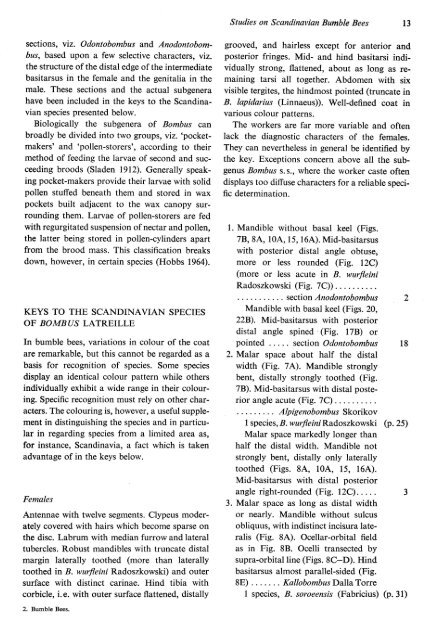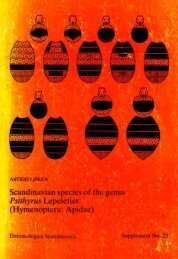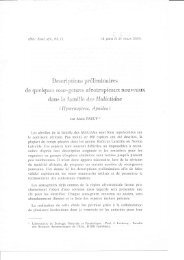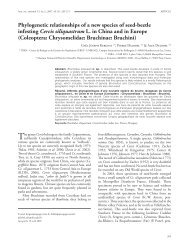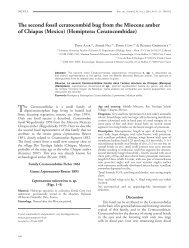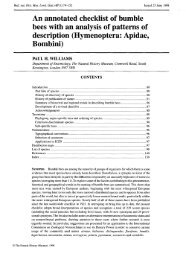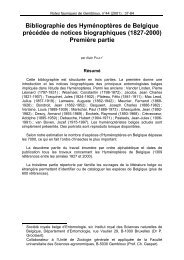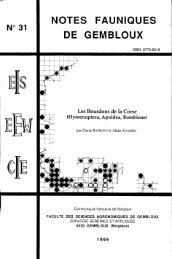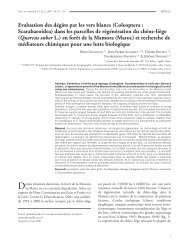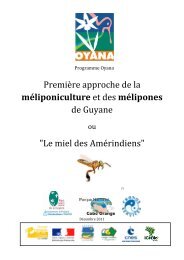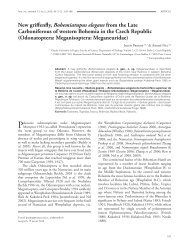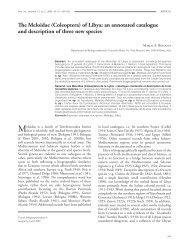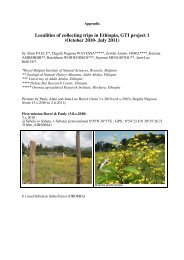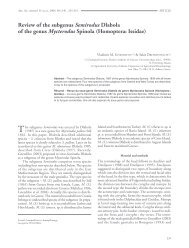Bumble Bees
Bumble Bees
Bumble Bees
Create successful ePaper yourself
Turn your PDF publications into a flip-book with our unique Google optimized e-Paper software.
Studies on Scandinavian <strong>Bumble</strong> <strong>Bees</strong> 13sections, viz. Odontobombus and Anodontobombus,based upon a few selective characters, viz.the structure of the distal edge of the intermediatebasitarsus in the female and the genitalia in themale. These sections and the actual subgenerahave been included in the keys to the Scandinavianspecies presented below.Biologically the subgenera of Bombus canbroadly be divided into two groups, viz.'pocketmakers'and 'pollen-storerso, according to theirmethod of feeding the larvae of second and succeedingbroods (Sladen l9l2). Generally speakingpocket-makers provide their larvae with solidpollen stuffed beneath them and stored in waxpockets built adjacent to the wax canopy surroundingthem. Lawae of pollen-storers are fedwith regurgitated suspension of nectar and pollen,the latter being stored in pollen-cylinders apaftfrom the brood mass. This classification breaksdown, however, in certain species (Hobbs 1964).KEYS TO THE SCANDINAVIANOF BOMBU,S LATREILLESPECIESIn bumble bees, variations in colour of the coatare remarkable, but this cannot be regarded as abasis for recognition of species. Some speciesdisplay an identical colour pattern while othersindividually exhibit a wide range in their colouring.Specific recognition must rely on other characters.The colouring is, however, a useful supplementin distinguishing the species and in particularin regarding species from a limited area as,for instance, Scandinavia, a fact which is takenadvant age of in the keys below.FemalesAntennae with twelve segments. Clypeus moderatelycovered with hairs which become sparse onthe disc. Labrum with median furrow and lateraltubercles. Robust mandibles with truncate distalmargin laterally toothed (more than laterallytoothed in -8. wurfleini Radoszkowski) and outersurface with distinct carinae. Hind tibia withcorbicle, i.e. with outer surface flattened, distallygrooved, and hairless except for anterior andposterior fringes. Mid- and hind basitarsi individuallystrong, flattened, about as long as remainingtarsi all together. Abdomen with sixvisible tergites, the hindmost pointed (truncate inB. Iapidarius (Linnaeus)). Well-defined coat invarious colour patterns.The workers are far more variable and oftenlack the diagnostic characters of the females.They can nevertheless in general be identified bythe key. Exceptions concern above all the subgenusBombu^s s. s., where the worker caste oftendisplays too diffuse characters for a reliable specificdetermination.1. Mandible without basal keel (Figs.78, 8A, 10A, 15, 164).Mid-basitarsuswith posterior distal angle obtuse,more or less rounded (Fig. lzc)(more or less acute in B. wurfleiniRadoszkowski (Fig. 7C)). . . section Anodontobombus 2Mandible with basal keel (Figs. 20,228). Mid-basitarsus with posteriordistal angle spined ' (Fig. 178) orpointed section OContobombus 182. Malar space about half the distalwidth (Fig. 7 A). Mandible stronglybent, distally strongly toothed (Fig.7B). Mid-basitarsus with distal posteriorangle acute (Fig. 7C)Alpigenobombus Skorikov1 specieS,B. wurfleini Radoszkowski (p. 25)Malar space markedly longer thanhalf the distal width. Mandible notstrongly bent, distally only laterallytoothed (Figs. 8A, 10A, 15, 164).Mid-basitarsus with distal posteriorangle right-rounded (Fig. lzc) 33. Malar space as long as distal widthor nearly. Mandible without sulcusobliquus, with indistinct incisura lateralis(Fig. 8A). Ocellar-orbital fieldas in Fig. 8B. Ocelli transected bysupra-orbital line (Figs. 8C-D). Hindbasitarsus almost parallel-sided (Fig.8E) ... Kallobombus DallaTorre1 species, B. soroeensis (Fabricius) (p. 31)2. <strong>Bumble</strong> <strong>Bees</strong>.


